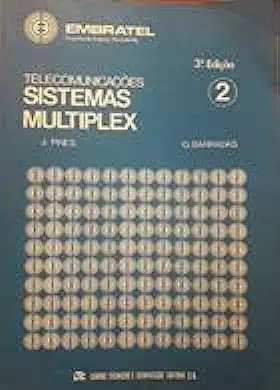
Telecommunications Multiplex Systems - J. Pines / O. Barradas
Telecommunications Multiplex Systems: A Comprehensive Guide
Introduction
In today's fast-paced world, efficient and reliable communication is essential for businesses and individuals alike. Telecommunications multiplex systems play a crucial role in meeting this demand by enabling the simultaneous transmission of multiple signals over a single communication channel. This book, "Telecommunications Multiplex Systems" by J. Pines and O. Barradas, provides a comprehensive and in-depth exploration of the principles, techniques, and applications of multiplex systems in telecommunications.
Key Features:
Comprehensive Coverage: This book covers a wide range of topics related to multiplex systems, from the fundamental concepts to advanced techniques and applications. It offers a thorough understanding of the subject matter, making it an invaluable resource for professionals, researchers, and students in the field of telecommunications.
Clear and Concise Explanations: The authors present complex concepts in a clear and concise manner, making the book accessible to readers with varying levels of expertise. Each topic is explained with the help of real-world examples, diagrams, and illustrations, enhancing the reader's understanding and retention of the material.
Practical Applications: The book emphasizes the practical applications of multiplex systems in various communication scenarios. It provides insights into the design, implementation, and performance evaluation of multiplex systems, enabling readers to apply the knowledge gained to real-world problems.
Chapter Overview:
Chapter 1: Introduction to Multiplexing: This chapter introduces the concept of multiplexing and its significance in telecommunications. It discusses the different types of multiplexing techniques, their advantages, and disadvantages, providing a foundation for understanding the subsequent chapters.
Chapter 2: Frequency Division Multiplexing (FDM): This chapter delves into the principles and techniques of FDM, a widely used multiplexing technique in analog communication systems. It covers topics such as frequency bands, channel allocation, and the impact of noise and interference on FDM systems.
Chapter 3: Time Division Multiplexing (TDM): This chapter explores TDM, a digital multiplexing technique that enables the transmission of multiple digital signals over a single channel. It discusses the concepts of time slots, synchronization, and framing, along with the advantages and limitations of TDM systems.
Chapter 4: Wavelength Division Multiplexing (WDM): This chapter introduces WDM, an optical multiplexing technique that utilizes different wavelengths of light to transmit multiple signals simultaneously. It covers topics such as wavelength allocation, optical components, and the benefits of WDM in high-speed optical communication systems.
Chapter 5: Code Division Multiplexing (CDM): This chapter explores CDM, a spread spectrum multiplexing technique that offers unique advantages in terms of security and interference resistance. It discusses the principles of spread spectrum communication, CDMA (Code Division Multiple Access), and the applications of CDM in wireless communication systems.
Chapter 6: Orthogonal Frequency Division Multiplexing (OFDM): This chapter introduces OFDM, a multicarrier modulation technique that has gained prominence in high-speed data transmission. It covers topics such as subcarrier modulation, orthogonality, and the benefits of OFDM in combating channel impairments.
Chapter 7: Advanced Multiplexing Techniques: This chapter explores advanced multiplexing techniques that extend the capabilities of conventional multiplexing systems. It discusses topics such as statistical multiplexing, dynamic bandwidth allocation, and the integration of multiplexing techniques for enhanced performance.
Conclusion:
"Telecommunications Multiplex Systems" by J. Pines and O. Barradas is an essential resource for anyone seeking a comprehensive understanding of multiplex systems in telecommunications. Its in-depth coverage, clear explanations, and practical examples make it an invaluable tool for professionals, researchers, and students alike. By mastering the concepts and techniques presented in this book, readers will gain the knowledge and skills necessary to design, implement, and optimize multiplex systems for efficient and reliable communication in various applications.